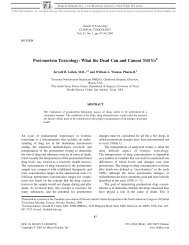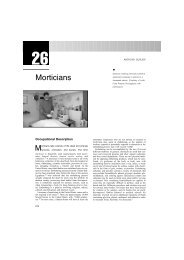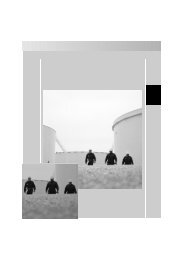9. Treatment of Amatoxin Poisoning-20 year retrospective analysis
9. Treatment of Amatoxin Poisoning-20 year retrospective analysis
9. Treatment of Amatoxin Poisoning-20 year retrospective analysis
Create successful ePaper yourself
Turn your PDF publications into a flip-book with our unique Google optimized e-Paper software.
730<br />
prevented both the rise <strong>of</strong> the liver enzymes and the fall<br />
<strong>of</strong> clotting factors in the blood. [276]<br />
Benzylpenicillin perfusions <strong>of</strong> isolated rat liver<br />
showed a strong inhibition <strong>of</strong> a-Ama toxicity. [277]<br />
Although most b-lactam antibiotics utilize a common<br />
carrier system for uptake into isolated hepatocytes, [278]<br />
kinetic studies <strong>of</strong> a-Ama absorption in hepatocytes<br />
proved that benzylpenicillin does not inhibit the<br />
membrane transport systems used by the toxin. An<br />
intracellular mechanism rather than interference with<br />
amanitin uptake appears responsible for the purported<br />
hepatoprotective effect. [279]<br />
Several theories have been advanced to explain the<br />
antitoxic action <strong>of</strong> benzylpenicillin. Floersheim’s<br />
hypothesis [280]<br />
that the drug could displace a-Ama<br />
from its binding site on serum protein is challenged by<br />
evidence that the toxic cyclopeptide does not bind to<br />
serum albumin. [266,281] Another hypothesis suggested<br />
that benzylpenicillin reduced or eliminated the GABAproducing<br />
intestinal flora involved in hepatic encephalopathy.<br />
[250,280] Although GABA appeared to be involved<br />
in experimental hepatic encephalopathy, the inhibitory<br />
neurotransmitter does not seem to play a role in human<br />
encephalopathy. [282]<br />
Other reports presented evidence <strong>of</strong> an anti-proliferative<br />
effect <strong>of</strong> b-lactam antibiotics on cultured<br />
eukaryotic cells including human sources and in vitro<br />
DNA replication systems. The intracellular target <strong>of</strong> blactams<br />
appears to be the replicative enzyme polymerase<br />
I. [283,284] Since the amatoxins, particularly a-Ama, are<br />
selective blockers <strong>of</strong> DNA-dependent RNA polymerase<br />
II, it is possible that the b-lactam antibiotics protect via<br />
their effects on eukaryotic DNA replication. [285]<br />
Although there is no formal pro<strong>of</strong>, in vitro experiments<br />
on chicken embryo hepatocytes and in vivo studies on<br />
mouse liver have shown that b-lactam antibiotics inhibit<br />
the toxic effect induced by a-Ama. [286]<br />
Unfortunately, benzylpenicillin commonly causes<br />
allergic drug reactions with an incidence <strong>of</strong><br />
1–10%. [126,287 – 289] The large amount <strong>of</strong> sodium ions<br />
administered with this antibiotic agent to amatoxinpoisoned<br />
patients may disrupt electrolyte balance. [290,291]<br />
Severe granulocytopenia has also been observed with<br />
high doses <strong>of</strong> benzylpenicillin. [292 – 294] Degradation<br />
products formed in vitro are <strong>of</strong>ten the causative agents<br />
<strong>of</strong> such adverse reactions rather than parent antibiotic.<br />
Use <strong>of</strong> freshly prepared single doses <strong>of</strong> benzylpenicillin<br />
prevents the majority <strong>of</strong> side effects. [295] However, given<br />
the bone narrow toxicity <strong>of</strong> b-lactams, these antibiotics<br />
[189,285] could affect all the hematopoietic cell<br />
lines. Lastly, massive benzylpenicillin therapy may<br />
MARCEL DEKKER, INC. 270 MADISON AVENUE NEW YORK, NY 10016<br />
©<strong>20</strong>02 Marcel Dekker, Inc. All rights reserved. This material may not be used or reproduced in any form without the express written permission <strong>of</strong> Marcel Dekker, Inc.<br />
evoke neurotoxic symptoms in patients with nervous<br />
system disease and renal insufficiency as well as induce<br />
convulsions when cerebral edema is imminent. [14,296]<br />
Although the biological mechanism <strong>of</strong> b-lactam<br />
antibiotics in the treatment <strong>of</strong> amatoxin poisoning is still<br />
unclear and high-dose benzylpenicillin can induce<br />
adverse reactions, the literature seems to support clinical<br />
benefits. Moroni et al. [297] reported 100% recovery for 33<br />
patients treated 1 or 2 days after ingestion <strong>of</strong> Amanita<br />
mushrooms with high doses <strong>of</strong> IV benzylpenicillin plus<br />
thioctic acid and steroids. Statistical <strong>analysis</strong> <strong>of</strong> a clinical<br />
study <strong>of</strong> <strong>20</strong>5 patients from Austria, France, Italy,<br />
Switzerland, and The Netherlands from 1971 to 1980<br />
found benzylpenicillin at 300,000–1,000,000 U/kg/day<br />
IV to be significantly associated with survival. [250,298]<br />
The suggested doses for benzylpenicillin are 40,000,000<br />
and 1,000,000 U/day in adults and children, respectively.<br />
[265] Benzylpenicillin is not approved by the US<br />
Food and Drug Administration (FDA) for treatment <strong>of</strong><br />
Amanita poisonings.<br />
In this <strong>20</strong>-<strong>year</strong> survey, benzylpenicillin was the most<br />
frequently used drug in the management <strong>of</strong> amatoxin<br />
poisoning, either as mono-chemotherapy in 164<br />
cases (10.1%, Table 3) or combined with other drugs<br />
as bi-chemotherapy (797 cases, 48.8%, Table 4), trichemotherapy<br />
(263 cases, 16.1%, Table 4), and polychemotherapy<br />
(187 cases, 11.5%, Table 6). In total,<br />
86.5% <strong>of</strong> Chem-group patients (1411/1632) receiving<br />
chemotherapy were treated with benzylpenicillin.<br />
Ceftazidime, a third generation cephalosporin, is<br />
several times more effective than benzylpenicillin by<br />
DNA replication systems testing in vitro. [284,286]<br />
According to the Neftel protocol, [196] ceftazidime is<br />
administered as 4.5 g IV every 2 hours. Despite the high<br />
drug concentrations in plasma, no renal and neurological<br />
side effects were reported. [197] Ceftazidime was the<br />
second most used b-lactam but was always combined<br />
with silybin (12 cases, Table 5).<br />
Silymarin Complex<br />
Enjalbert et al.<br />
Silymarin is a hepatoprotectant complex <strong>of</strong> natural<br />
substances isolated from seeds <strong>of</strong> Mediterranean milk<br />
thistle, Silybum marianum (L.) Gaertn. (Asteraceae ). [299]<br />
This flavonolignan group includes the three isomers<br />
silydianin, silychristin, and the major compound,<br />
silybin. [300,301] The beneficial effects <strong>of</strong> silymarin on<br />
death rate and survival time in intraperitoneal (IP)<br />
administered mice with a-Ama were reported by Hahn<br />
et al. [302] Silymarin efficacy depended on both the delay<br />
between intoxication and therapy, and the degree <strong>of</strong> liver








